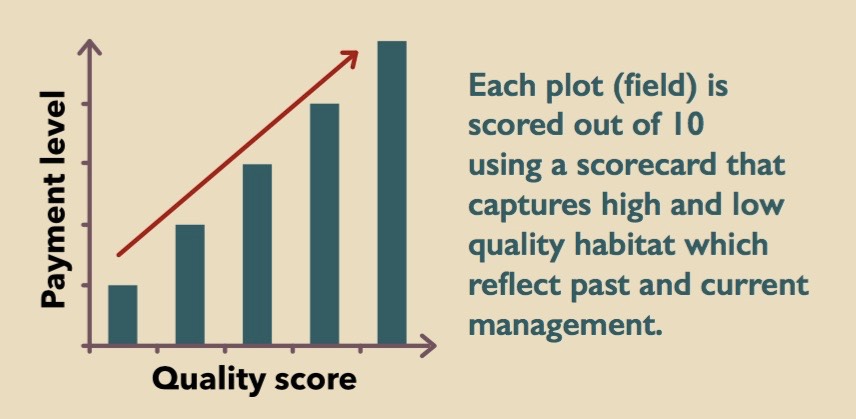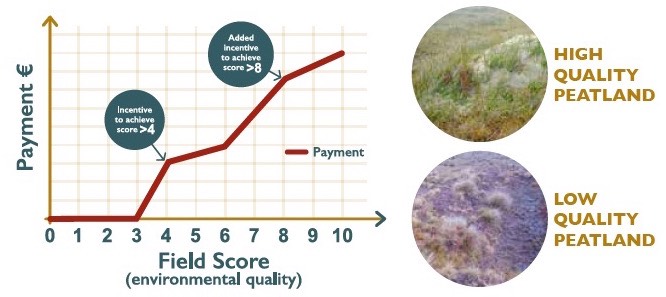Payments are linked to the nature quality of your farm
Higher nature quality = Higher payment level Programme Results Indicators

There are three features of the farm that can be measured to determine the environmental result achieved, habitat quality, floodplain quality and watercourse condition.
Habitat quality
The management of farmland has a direct influence on the freshwater environment within pearl mussel catchments. Higher quality farmland habitats provide better conditions for freshwater pearl mussel in the main rivers. For this reason the three main farm habitats (grassland, peatland, and woodland) are used as results indicators for the Programme. The result is determined following a ‘habitat quality assessment’ of the farm.
Habitats assessed are grasslands, peatlands and scrub/woodlands
Floodplain quality
Lands that flood (floodplains) along freshwater pearl mussel rivers are important for maintaining good conditions for freshwater pearl mussel during periods of high flow. A functioning floodplain has the effect of slowing the rate and reducing the volume of flow. This is best achieved where high quality habitats occupy the floodplain. The provision of high quality floodplains along freshwater pearl mussel rivers will therefore be rewarded through the Programme.

Watercourses and farm management
Other farm features and activities which contribute to water quality within freshwater pearl mussel rivers include; condition of watercourses (drains, streams, and rivers), farmyard management, and nutrient application. The Programme has incorporated these features and activities into an overall farm result which determines the final results-based payment. The result is determined following a ‘whole-farm assessment’.
How results are measured
Habitat quality assessment
Habitat quality will be assessed at the plot (field) level using a scorecard for each habitat. The score cards award marks for various aspects of the habitat which reflect quality such as; plant species, vegetation structure, wetness, exposed soil, and damaging activities.
Habitats achieve a final score on a scale of 0 (low) to 10 (high). Better quality habitats will obtain higher scores and result in higher payments.

Floodplain assessment
Those lands which occur along the main freshwater pearl mussel river channel qualify as floodplains in the Programme.
The result achieved is based on the average habitat quality score of all floodplain plots on an individual farm.
Whole-farm assessment
Each farm (or parcel in the case of commonage) is subject to a whole-farm assessment of water quality impacts and risk.
There are three assessments that give rise to the final result:
Watercourse condition. All watercourses (streams, rivers, drains) are assessed in relation to risks arising from flow, livestock, sediment, and nutrients. Watercourses are scored according to four categories from poor to excellent.
Farm nutrient balance. This assessment applies mainly to those farms where cattle are housed over winter. It considers the number of animals housed (slurry generated), appropriate nutrient application rate, and the extent of available spread lands. The outcome of this assessment is scored according to three categories from poor to adequate. Application of chemical Phosphorus (P) within freshwater pearl mussel catchments presents a major risk to water quality. The use of chemical P by participants is only permitted following provision of soil samples demonstrating deficiency and subsequent approval by the Project Team.
Farmyard management. This assessment identifies any risk of point source pollution to watercourses.
The outcome of the whole-farm assessment fits into one of four categories as follows:
poor | inadequate | good | excellent
This result is used to determine the final results-based payment to the farmer.